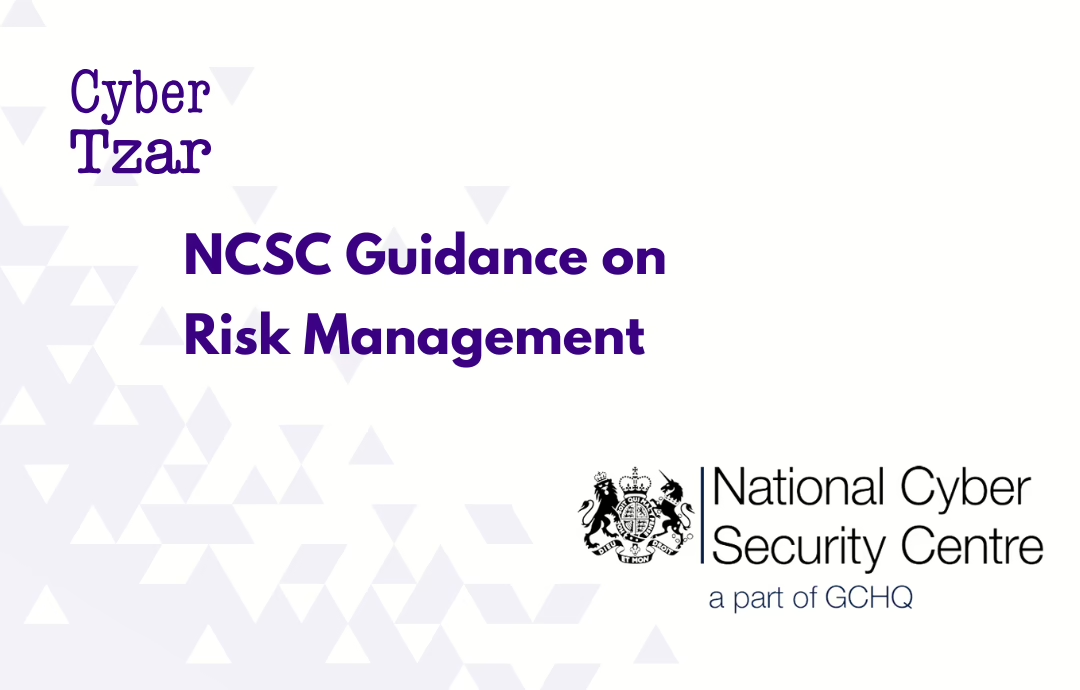The National Cyber Security Centre (NCSC) guidance on Risk Management provides a structured and practical framework for understanding, assessing, and mitigating cyber security risks. It combines theoretical approaches, tools, and practical exercises to ensure comprehensive risk management for organisations of all sizes. Below is a detailed summary and overview:
Core Topics and Structure
- Introduction to Risk Management
- Focuses on the basics of cyber risk and the importance of structured approaches.
- Emphasises iterative risk management to adapt to evolving threats and technologies.
- Cyber Security Risk Management Framework
- A step-by-step approach:
- Define the scope and context.
- Understand assets, threats, and vulnerabilities.
- Prioritise risks and determine treatments.
- Develop and continually update assurance plans.
- A step-by-step approach:
- Types of Risk Management Approaches
- System-Driven: Focuses on overarching system goals, interactions, and losses.
- Component-Driven: Analyses specific system components like hardware, software, and processes.
- Both approaches are complementary and should be applied contextually.
- Risk Quantification
- Explains how to quantify cyber risks using metrics like likelihood, downtime, or financial cost.
- Dispels myths, such as needing large datasets or mathematical expertise for effective quantification.
- Assurance Models
- Provides a framework for gaining and maintaining confidence in risk treatments:
- Intrinsic assurance (e.g., inherent trustworthiness of components).
- Extrinsic assurance (e.g., certifications).
- Implementation assurance (e.g., proper configuration).
- Operational assurance (e.g., monitoring and patching).
- Provides a framework for gaining and maintaining confidence in risk treatments:
- Tools and Techniques
- Attack Trees: Visual hierarchies showing potential attack paths to identify weaknesses.
- Threat Modelling: Analyses systems and services to predict how they might be attacked.
- Scenario Planning:
- Scenario-Based Exercises: Test incident response plans (e.g., tabletop exercises, functional drills).
- Future Scenario Planning: Explore ‘what if’ scenarios to prepare for rare, high-impact events.
- Implementation and Practical Considerations
- Encourages collaboration through workshops and team-based activities.
- Stresses the importance of tailoring frameworks to organisational size, sector, and needs.
- Offers guidance on integrating risk management into business-as-usual activities.
Key Features
- Adaptability: Techniques like scenario planning and quantification are designed to evolve with changing threats and organisational contexts.
- Comprehensive Coverage: From understanding basic risks to applying advanced tools like attack trees and threat modelling.
- Focus on Practicality: Clear steps and examples, including tools like NCSC’s “Exercise in a Box,” ensure guidance is actionable.
- Emphasis on Iteration: Encourages continuous improvement and regular updates to risk assessments and mitigation plans.
Who This Is For
- Public Sector: Government departments handling sensitive data and critical services.
- Small & Medium Enterprises (SMEs): Organisations with limited resources needing scalable, cost-effective approaches.
- Large Enterprises: Complex businesses requiring detailed frameworks and quantification methods.
- Cyber Security Professionals: Specialists tasked with implementing or advising on cyber risk management.
Highlights by Section
Step-by-Step Risk Assessment
- Understand Assets: Identify what needs protection and why (e.g., systems, data, processes).
- Assess Threats: Consider threat actors, motivations, and capabilities.
- Evaluate Vulnerabilities: Use tools like CVE databases and MITRE ATT&CK.
- Estimate Impact and Likelihood: Use qualitative/quantitative measures to determine risk.
- Prioritise Risks: Focus on high-priority risks and develop treatment plans.
Tools for Analysis
- Attack Trees: Systematically deconstruct attack pathways.
- Threat Modelling: Structured questioning to predict potential failures or breaches.
- Risk Matrices: Combine likelihood and impact for risk prioritisation.
Assurance and Scenarios
- Assurance: Iterative mechanisms to verify that risk treatments remain effective over time.
- Scenarios: Both reactive (e.g., response to incidents) and proactive (e.g., preparing for future threats).
Practical Applications
- Create playbooks for common incidents like ransomware attacks.
- Use system-driven approaches for complex integrations (e.g., cloud migrations).
- Apply component-driven methods for operational dependencies (e.g., unpatchable systems).
- Regularly test risk assumptions through exercises and iterative reviews.
This guidance provides a robust foundation for organisations at any stage of their cyber security journey, from beginners looking for a simple starting point to advanced users seeking to refine their risk management practices.


